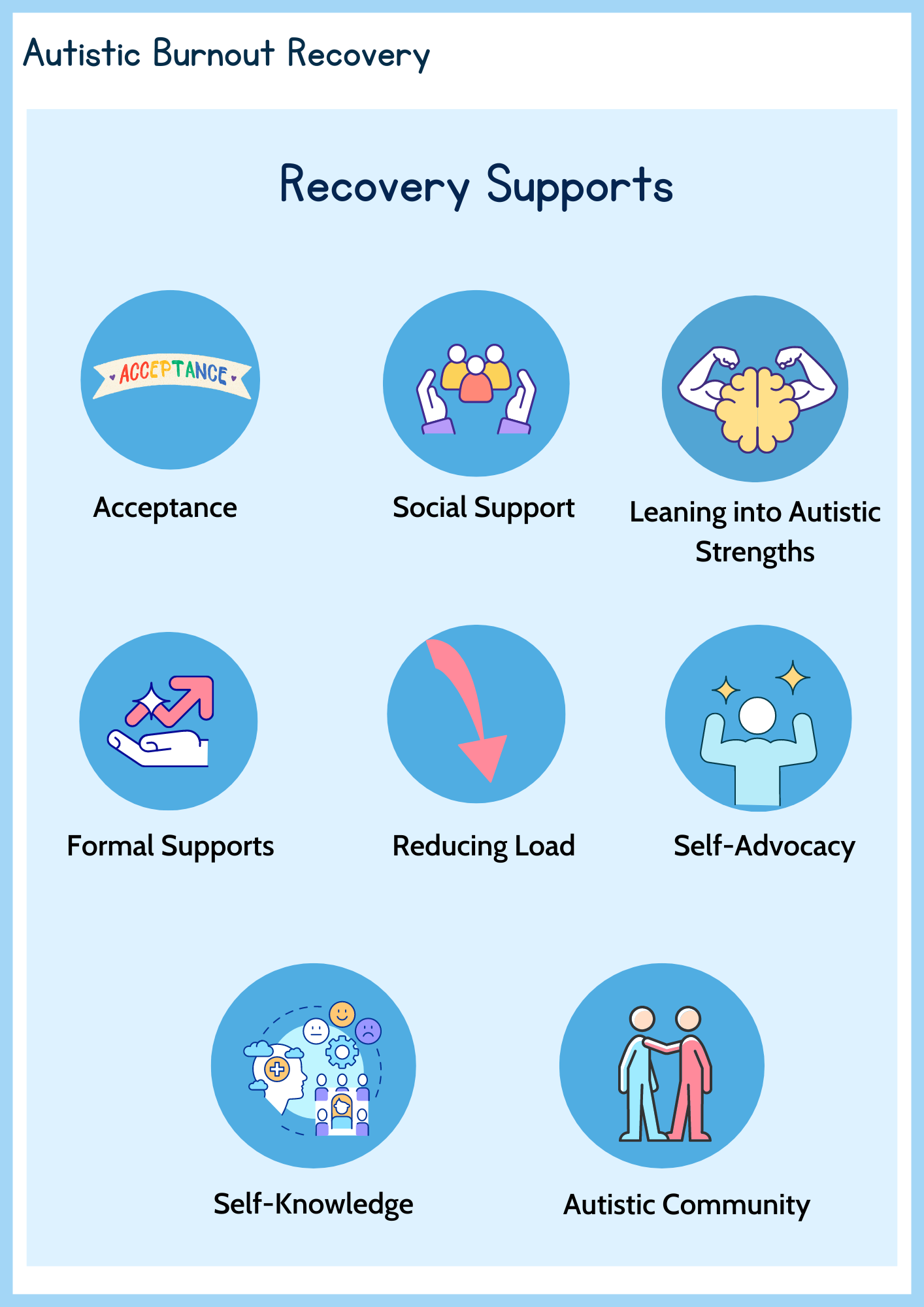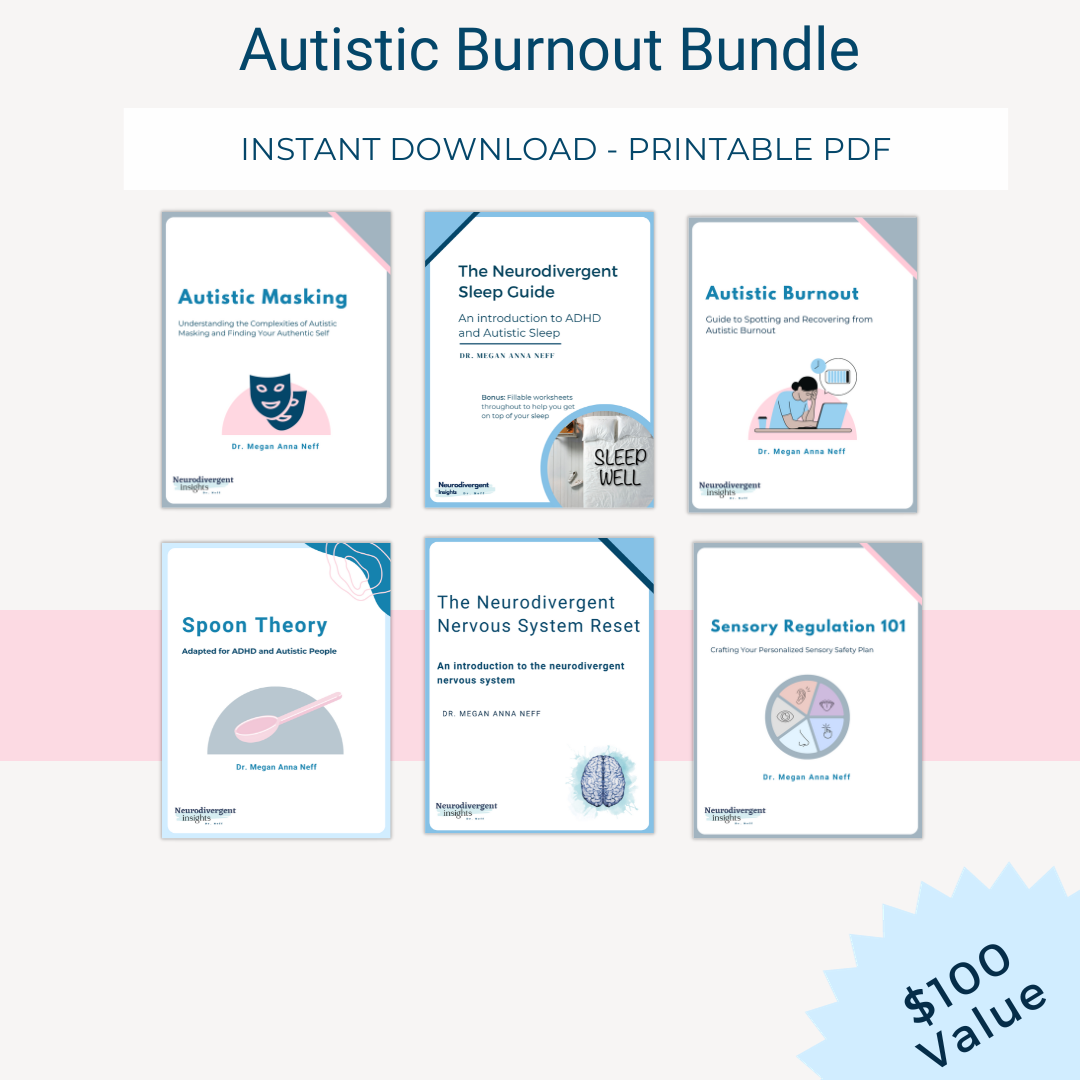Autism and Burnout
Autistic Burnout
Few studies have looked at Autistic burnout, which, unfortunately, means it is mainly missing from academic and clinical literature. So it is no surprise that few clinicians have heard of or understand how to work with Autistic burnout! Slowly awareness is growing as more and more Autistic self-advocates openly talk about their experiences with Autistic burnout.
Raymaker et al. recently published one of the first studies on autistic burnout, appropriately titled: “Having All of Your Internal Resources Exhausted Beyond Measure and Being Left with No Clean-Up Crew: Defining Autistic Burnout." The Raymaker study was the first to put forward a clinical definition of Autistic burnout.
Autism Burnout Defined
Autistic burnout is characterized by pervasive, long-term (typically 3+ months) exhaustion, loss of function, and reduced tolerance to stimulus. (Raymaker et al., 2021). Autistic burnout is characterized by three core features: 1) pervasive exhaustion, 2) loss of skills, and 3) increased sensory sensitivities. Autistic burnout is long-term. To reach the clinical definition of Autistic burnout syndrome, it must be present for 3 months or longer (Raymaker et al., 2021).
Autistic burnout results from chronic life stress. For high-masking Autistic people, this often results from expectations and pressures that come from trying to live up to allistic (non-Autistic) expectations.
The three primary characteristics of Autistic burnout include
1) Chronic exhaustion
2) Reduced tolerance to stimulus (increased sensory sensitivities)
3) Loss of skills (e.g., reduced executive functioning such as thinking, remembering, creating and executing plans, performing basic self-care skills, and activities in daily living).
One important thing to understand about Autistic burnout is that this is not the same as occupational burnout or depression. Autistic burnout can look like depression; however, it needs to be supported differently. Similarly, while Autistic burnout shares similar features as occupational burnout, it is different and requires different support.
Because Autistic burnout is distinct from occupational burnout and depression, it needs to be treated differently. We need to have specific training, education, and support to address Autistic burnout.
Autistic burnout is not just your run-of-the-mill work or career burnout.
Career burnout is typically talked about as a sense of physical and emotional exhaustion, de-realization, loss of meaning, and a reduced ability to accomplish things. While Autistic burnout certainly includes these elements, it is more body-based and all-encompassing than career burnout.
Raymaker et al. were one of the first to study Autism burnout in an empirical study. They found several distinct differences between occupational and Autistic burnout.
Occupational Burnout vs. Autistic Burnout
Distinctions between occupational and Autistic burnout include:
Autism burnout involves a LOSS of functioning (for example, a loss of executive functioning, the ability to regulate attention and focus, organize and break down projects, and verbal abilities all suffer).
Our sensory system is aggravated when we're in burnout, so we often experience heightened sensory sensitivities.
Autistic burnout is characterized by pervasive EXHAUSTION (physical, mental and emotional). Many Autistic people struggle with chronic fatigue. Autism burnout likely contributes to chronic fatigue issues.
Autism Burnout is a leading pathway of Autistic depression and suicidality! (And this is why it is so important clinician's learn about Autistic burnout!)
Other Symptoms of Autistic Burnout
In addition to the intense emotional, physical, and mental exhaustion, it can also result in difficulty managing emotions which makes a person more prone to outbursts or intense anxiety. It can also result in an increase in neurodivergent traits such as repetitive behaviors, reduced tolerance for sensory sensitivities, increased difficulty adapting to change, and increased difficulties with memory and focus.
What Causes Autistic Burnout?
Research on Autistic burnout shows that burnout happens when demands exceed the ability to cope. The Autistic burnout equation looks like something like this: When the overall load exceeds coping abilities + supports = burnout.
Some of the most common contributors to burnout include:
Masking
Having social/sensory needs minimized by others due to appearing "fine" (i.e., masking)
Not having access to the appropriate level of supports & accommodations
Executive functioning fatigue following several stressors or transitions
When the overall load exceeds abilities + supports = burnout
Autistic Burnout Recovery
Autistic burnout recovery typically involves rest, self-care, healthy boundaries, and nourishing practices. However, recovery can take all shapes and sizes.
For some, it will look like significant time resting and sleep. For others, it may involve eating the same foods repeatedly. Or it may look like spending time with your special interests.
On a more systemic level, it can also look like restructuring your life. You may re-consider your relationship to food, alcohol, health, movement, sleep, work, and your sensory environment. Creating a sustainable life often involves re-evaluating the concept of "normal" to create a new normal. Building a life that works for you will likely take creativity and commitment; these things don't happen overnight.
Recovery depends on the person and the specific causes. In the situation of acute burnout (like the person who gets tunnel vision while at a party), they need to go home and rest for the night and will likely regain vision and skills in the morning. For a more prolonged season of burnout, a person may need to significantly restructure their lifestyle and remove themselves from the causes of their burnout. It may become more difficult to recover the older a person is.
The following themes came up in Raymaker's interviews with Autistic adults. Autistic adults identified the following themes as helpful in their burnout recovery.
Acceptance and Access to Social Support: Accessing individual and community support, peer support, attending to autistic needs, and time spent unmasking. Advocating for and receiving reasonable accommodations.
Leaning into Autistic Strengths: Using Autistic strengths and special interests. Formal Supports: Mental health supports, time off, breaks, and the ability to socially withdraw.
Reducing Load: Reducing activities, setting boundaries, and asking for help.
Self-Advocacy and Health: Focusing on a healthy lifestyle, receiving an Autism diagnosis.
Self-Knowledge: Understanding patterns and triggers and making strategic decisions to be preventative.
Engagement with the Autistic Community: Engagement with the autistic community can help a person name and validate their experience of burnout.
Following are some of my personal go-to tips for recovering from burnout:
Attend to the sensory! Moving in ways that feel natural and good, reducing sensory load, engaging in sensory activities that are restorative
Spend time unmasked (again, masking is consistently one of the highest predictors of burnout).
Ensure appropriate accommodations are in place (at school, work, etc.).
Practicing good boundaries in relationships (we have fewer spoons, so it’s important to protect our energy through healthy boundaries).
Engage in enlivening activities (special interests, passions, time alone, or with those whom you can safely unmask).
Support healthy rhythms by prioritizing healthy sleep hygiene, routines, & practices.
Sources:







